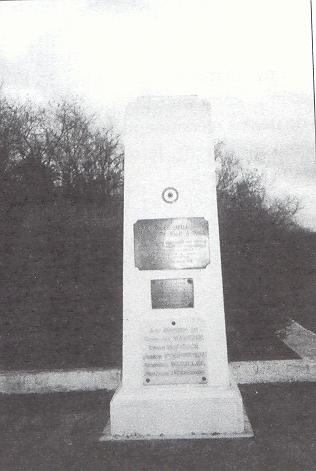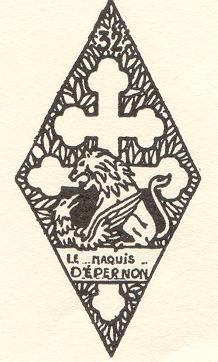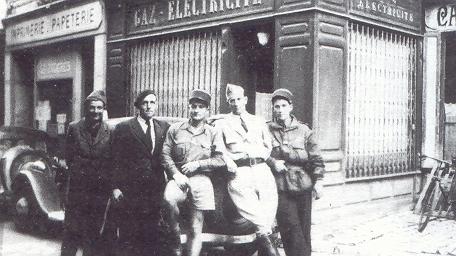 The
RESISTANCE in Touraine
The
RESISTANCE in Touraine
Made by Camille and Sabrina
|
|
The “Resistance” began when France was occupied. In our region the Resistance was typified by the ferrymen's activity. Even though Resistance took different forms.
At the beginning of the war, the Resistance was above all an individual affair. Afterwards it had been organised.
The Resistance at Loches began by many symbolic acts such as distributing anti-Nazi tracts or writing the Resistance motto on walls.
Loches was an important place for the Resistance because it was a place in the occupied part of France close to the free part. So it was a passage point for reaching England. Its situation explains the fact that a lot of allied intelligent agents were parachuted in our sector.
To organise this strategic area, an important substructure was necessary, mainly to recover piece of information, to find shelters, to hide the illegal armament, or to locate fields able to serve as landing-ground.
Most of the ferrymen were farmers whose farms were next to the dividing line. There were two types of ferrymen:
Some gave only little information when people asked them.
Some drove people in order to pass the dividing line where it was lesser supervised .
Testimony: In Cormery, the boss of « Le Café de la girafe » testified : « Chaque nuit, le patron du « Café de la Girafe », à Cormery, son frère, son neveu et ses deux fils, âgés de 8 et 18 ans, passaient en moyenne une soixantaine de personnes, qu’il pleuve, qu’il neige, qu’il vente, rien n’était un obstacle, pas même le clair de la lune. « Fidèle », la belle chienne [...] en aurait à nous dire … N’était-elle pas le pionnier de la bande ? Accompagnée de son maître, elle précédait le convoi de 150 mètres. La présence allemande, soudain la faisait grogner. Un béret jeté sur sa tête éteignait la lumière de ses yeux. La patrouille était donc là ! Un coup de lampe : tout le monde se cache ! deux coups : en avant ! »
Arrests were due to denunciations. By this way, a lot of channels disappeared, especially, a channel passing by Vou, a little village near Loches ( around “Le Jardin” ). Emile Maurice, his daughter Germaine, and Joseph Pouponneau died at Auschwitz, because they were accused of being ferrymen.

Memorial for the ferrymen dead in transportation,Vou.
Jail penalties against ferrymen were about 2 and 4 months. The most active Ferrymen were condemned to many years of forced labour with transportation in concentration camp.
Testimony: Mrs Pascual about the arrest of her husband, a resistant:
« […] On est venu chercher Michel à l'hôtel, rue Quintefol. Des allemands en civil dans deux voitures.[…]. Ils l’ont d’abord emmené dans une cave que nous avions un peu plus loin dans la rue, là, ils n’ont rien trouvé. Puis, ils l’ont conduit dans notre deuxième cave, rue des Roches : là, ils ont mis la main sur tout un matériel compromettant.
Conduit au Palais de justice de Loches, Michel a tenté de s’échapper. Mais en vain …. Ce fut ensuite la prison de Tours.[…..]
Puis ce fut le départ pour Compiègne et les camps de concentrations : Buchenwald, Dachau , Mauthausen et Flussenburg. A la libération des camps, Michel s’est évadé le 2 mai 1945, avant la mise à mort des détenus. »
ORA's MAQUIS ( Organisation de résistance armée: organisation of armed resistance )
After the Armistice signed by Pétain, few officers decided to create an armed movement of Resistance: the ORA was born. This movement spread in all the French territory. Touraine was divided into two parts, by the demarcation line. So there were two grouping:
The Maquis of Cesario was bound to” Indre-et-Loire” ( Northern part )
The Maquis of Epernon was fastened to “Indre”, ( Southern part)
The Maquis of Epernon was the 32nd Infantry regiment of the former “Armistice army”.
In June 1940, the 3rd motorised infantry division ( DIM), in reserve of the headquarters was constituted of many regiments. After having been brought into action in very murderous fights the 3rd DIM was brought to Loches ( on August 25th , 1940), to hold posts on the dividing line.
On August 8th, the Maquisscrub of Césario was mixed with the Maquis of Epernon, in order to improve their actions in efficacity.

Emblem of the scrub of Epernon.
Lieutenant- Colonel Costantini explains us the creation of the Maquis of Epernon :
“J’ai été pressenti, après la dissolution de l’armée d’Armistice, par le Général Chomel, alias Charles–Martel, chef de l’ORA dans l’Indre, pour reconstituer le 32e RI. […]
A la date du 1er mars 1943, j’avais réuni un « noyau mobilisateur » constitué exclusivement par des cadres actifs volontaires ... C’est le Général Chomel qui décida de mon pseudonyme et décida que la formation que je mettrai sur pied porterait le nom de corps d’Epernon. La zone d’action qui me fut signée correspondait à la partie du département d’Indre et Loire, située au sud et sud-est de la ligne de Démarcation .... »
fait le 26 Août 1947.
In 1944, a mysterious Mr Jan (later Lecoze) arrived at Beaulieu-lés-Loches and settled as a doctor.
Lecoze presented himself as a member of the secret army. He said he was an escaped of the reprisals camp of Drancy. He added his wife and his daughter were killed by the Germans. He took refuge to St Hippolyte, then to Perrusson, where he created his own Maquis with two friends. The Maquis of Lecoze was mainly formed of young people, greedy of actions. In fact the main resources of his Maquis was made of looting.

Lecoze and his friend, in Loches.
Lecoze was in fact Georges Duboscq, an old-lag, convicted to 60 years of jail and to 95 years of suspension of civil rights. Prominent of 18 murders, a lot of pillages and collaboration with the occupant, Georges Duboscq ,was shoot down, May 14th,1946, in Angers jail.
|
|
|